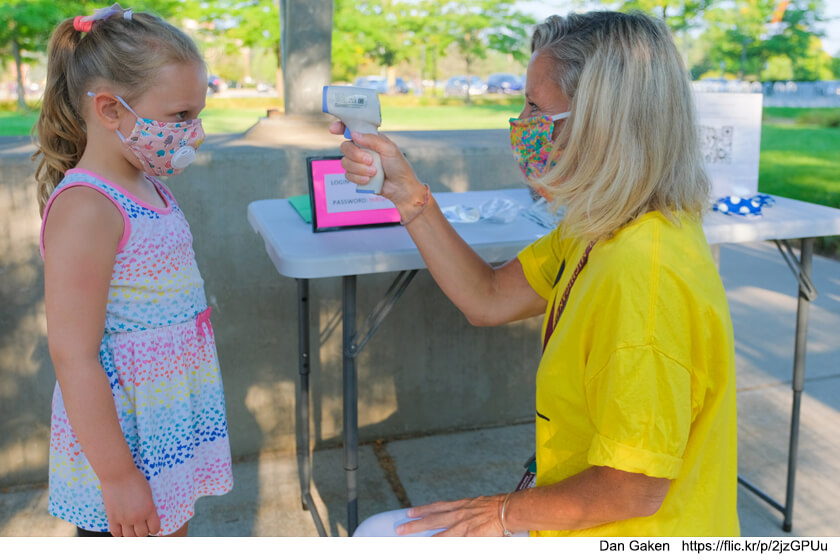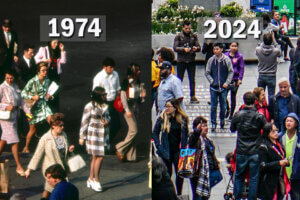West Long Branch, NJ – Covid anxieties have risen since the summer as President Donald Trump continues to receive poor marks for his response to the coronavirus outbreak and low confidence that he can guide the country into recovery. In fact, more voters have faith in his opponent on this score. The Monmouth (“Mon-muth”) University Poll also finds that a bare majority of Americans are satisfied with how their state is handling school reopenings in the midst of the pandemic, but fewer are happy with the federal government’s help with the start of the school year.
Public opinion of Trump’s handling of the coronavirus outbreak remains negative. Currently, 37% say he has done a good job and 56% say he has done a bad job. The president’s positive rating on dealing with the pandemic has hovered between 40% and 42% since May and his negative rating has ranged from 51% to 57%. He earned a more divided 46% good and 49% bad rating in April and a nominally positive 50% good and 45% bad rating in March.
The president’s overall job approval rating is holding basically steady at 41% approve and 53% disapprove. Over the past four months, Trump’s job approval number has ranged between 41% and 43% while his disapproval number has ranged between 51% and 54%. His best job rating since taking office was 46% approve and 48% disapprove in March this year.
Among registered voters, 44% say they are at least somewhat confident that Trump can put the country on the road to recovery from the pandemic, while 56% are either not too or not at all confident. These results stood at 45% confident and 54% not confident in August. By comparison, 53% of American voters are confident in Joe Biden’s ability to help the country recover and 45% are not confident. These results were 48% and 48%, respectively, one month ago.
“Changes in the president’s overall job rating and his handling of the pandemic have not moved appreciably. We seem to be at a point where the pandemic isn’t having any more of an impact on the 2020 election than we’ve been seeing since the summer,” said Patrick Murray, director of the independent Monmouth University Polling Institute.
Most Americans (55%) say the coronavirus outbreak has had a major impact on their daily lives. This is up from 50% who said the same in early June and a return to where this figure stood in May (56%). Another 29% say the outbreak has had a minor impact and 16% say it has had no impact.
Nearly half (47%) of the public say they are very concerned about someone in their family becoming seriously ill from the virus. This level of concern has increased from 41% in August. In fact, this number had been hovering between 37% and 42% for the last four months. The current results are more similar to April’s poll, when 50% were very concerned about a family member becoming ill from COVID-19, which itself was a jump from 38% in March at the start of the outbreak. In the current poll, another 27% are somewhat concerned and 1 in 4 are either not too (13%) or not at all (12%) concerned.
“Labor Day generally serves as a marker for returning to a more normal flow of life. That’s not happening this year and could be leading to an increase in anxiety levels,” said Murray.
Unease about Covid continues to be driven primarily by partisanship and race. Currently, 68% of Democrats say they are very concerned about a family member getting ill, but only 43% of independents and 30% of Republicans feel the same. There are also racial differences on this question – 59% of those who are Black, Latino, Asian or another race report being very concerned versus 41% of whites who say the same. This racial gap holds even when controlling for partisan affiliation.
At the same time that concerns about getting ill have ticked up, expectations for another wave have ticked down – although a majority (57%) still think we will see another surge in coronavirus cases sometime over the next year. By comparison, 39% of Americans think the rate of new cases will continue to decline. In early June, 69% expected another surge and 26% expected cases to decline. Anticipation of another surge has dropped most among independents (from 76% in June to 57% now), followed by Democrats (from 85% to 76%) and Republicans (from 41% to 34%).
The public remains cautious about reopening the country in the midst of the pandemic. Nearly 6 in 10 (58%) are more concerned that states are lifting restrictions too quickly compared with 32% who are more concerned this is not happening quickly enough. There is a wide partisan gap in these results between those who say restrictions are being lifted too quickly – 82% of Democrats, 60% of independents, and 30% of Republicans – and those who say too slowly – 56% of Republicans, 31% of independents, and 12% of Democrats. These results have been fairly consistent since May.
There is no partisan split, though, on how states are handling the reopening of schools this fall. Overall, 52% of the public is satisfied and 41% is dissatisfied. Satisfaction with how schools are reopening comes from 54% of Democrats, 52% of independents, and 51% of Republicans. There is no difference in overall satisfaction with how states are handling the start of the new school year between parents of children under 18 (52%) and non-parents (52%).
Partisanship is a driving force, though, when Americans are asked about the guidance and assistance provided by the federal government to help the states with the reopening of schools. Only 36% say Washington has provided enough support for this while 57% say it has not. Those saying the federal government has done enough for schools ranges from 58% of Republicans, to 37% of independents and 13% of Democrats.
“The federal-state divide is where we see partisanship raise its head. Governors and state officials tend to generate some cross-aisle support, but opinion of the federal government is filtered almost entirely through a partisan lens,” said Murray.
The Monmouth University Poll also finds that state governors continue to get broadly positive reviews for their handling of the pandemic – 61% good job and 35% bad job. This result is slightly improved from 57% to 35% in August. Prior to that, the good job rating for governors ranged between 65% and 73% since the outbreak began in March.
Reviews are much poorer for the actions of our fellow Americans. Just 31% say the American public has done a good job dealing with the outbreak while 57% say their fellow Americans have done a bad job. These results are slightly better than Monmouth polls taken in August (26% good job to 62% bad job) and late June (28% to 59%), but opinion of our neighbors’ behavior was more positive in early June (46% good job to 43% bad job) and May (51% to 33%). Current sentiment about the American public’s behavior in response to the pandemic is worse than it was even at the outset of the crisis (38% good job to 48% bad job in April and 38% to 45% in March).
While the president, state governors, and the American public all get different ratings on dealing with the current health crisis, reviews for Trump are by far the most divided along partisan lines. The vast majority of Republicans (77%) give the president a good rating on how he has handled the pandemic, while only 34% of independents and just 5% of Democrats agree. This partisan gap is present for the nation’s governors, but is nowhere near as large – ranging from 70% good job among Democrats, to 60% among independents, and 52% among Republicans. Partisan ratings of the American public’s behavior range from 39% good job among Republicans, 31% among independents, and 24% among Democrats.
Overall, 27% of the public says the country is going in the right direction while 66% says things are headed down the wrong track. This metric is slightly improved from the record low in late June (18% right direction to 74% wrong track), but still more negative than at the start of the pandemic in March (39% to 54%).
The Monmouth University Poll was conducted by telephone from September 3 to 8, 2020 with 867 adults in the United States. The question results in this release have a margin of error of +/- 3.3 percentage points. The poll was conducted by the Monmouth University Polling Institute in West Long Branch, NJ.
QUESTIONS AND RESULTS
(* Some columns may not add to 100% due to rounding.)
[Q1-5 held for future release.]
6. Do you approve or disapprove of the job Donald Trump is doing as president?
| TREND: | Sept. 2020 | Aug. 2020 | Late June 2020 | Early June 2020 | May 2020 | April 2020 | March 2020 | Feb. 2020 | Jan. 2020 |
| Approve | 41% | 41% | 41% | 42% | 43% | 44% | 46% | 44% | 43% |
| Disapprove | 53% | 53% | 53% | 54% | 51% | 49% | 48% | 50% | 52% |
| (VOL) No opinion | 5% | 7% | 7% | 4% | 6% | 6% | 6% | 5% | 5% |
| (n) | (867) | (868) | (867) | (807) | (808) | (857) | (851) | (902) | (903) |
| TREND: Continued | Dec. 2019 | Nov. 2019 | Sept. 2019 | Aug. 2019 | June 2019 | May 2019 | April 2019 | March 2019 | Jan. 2019 | Nov. 2018 | Aug. 2018 | June 2018 | April 2018 | March 2018 | Jan. 2018 |
| Approve | 43% | 43% | 41% | 40% | 41% | 40% | 40% | 44% | 41% | 43% | 43% | 43% | 41% | 39% | 42% |
| Disapprove | 50% | 51% | 53% | 53% | 50% | 52% | 54% | 51% | 54% | 49% | 50% | 46% | 50% | 54% | 50% |
| (VOL) No opinion | 8% | 6% | 6% | 7% | 9% | 8% | 6% | 5% | 5% | 8% | 7% | 11% | 9% | 8% | 8% |
| (n) | (903) | (908) | (1,161) | (800) | (751) | (802) | (801) | (802) | (805) | (802) | (805) | (806) | (803) | (803) | (806) |
| TREND: Continued | Dec. 2017 | Sept. 2017 | Aug. 2017 | July 2017 | May 2017 | March 2017 |
| Approve | 32% | 40% | 41% | 39% | 39% | 43% |
| Disapprove | 56% | 49% | 49% | 52% | 53% | 46% |
| (VOL) No opinion | 12% | 11% | 10% | 9% | 8% | 11% |
| (n) | (806) | (1,009) | (805) | (800) | (1,002) | (801) |
7. Would you say things in the country are going in the right direction, or have they gotten off on the wrong track?
| TREND: | Sept. 2020 | Aug. 2020 | Late June 2020 | Early June 2020 | May 2020 | April 2020 | March 2020 | Feb. 2020 | Jan. 2020 |
| Right direction | 27% | 22% | 18% | 21% | 33% | 30% | 39% | 37% | 37% |
| Wrong track | 66% | 72% | 74% | 74% | 60% | 61% | 54% | 57% | 56% |
| (VOL) Depends | 4% | 4% | 5% | 4% | 4% | 5% | 4% | 6% | 6% |
| (VOL) Don’t know | 3% | 2% | 3% | 1% | 3% | 5% | 3% | 1% | 1% |
| (n) | (867) | (868) | (867) | (807) | (808) | (857) | (851) | (902) | (903) |
| TREND: Continued | Dec. 2019 | Nov. 2019 | Sept. 2019 | Aug. 2019 | June 2019 | May 2019 | April 2019 | March 2019 | Nov. 2018 | Aug. 2018 | June 2018 | April 2018 | March 2018 | Jan. 2018 |
| Right direction | 32% | 30% | 30% | 28% | 31% | 29% | 28% | 29% | 35% | 35% | 40% | 33% | 31% | 37% |
| Wrong track | 56% | 61% | 61% | 62% | 62% | 63% | 62% | 63% | 55% | 57% | 53% | 58% | 61% | 57% |
| (VOL) Depends | 8% | 7% | 6% | 8% | 6% | 4% | 7% | 6% | 7% | 6% | 3% | 5% | 6% | 3% |
| (VOL) Don’t know | 4% | 2% | 2% | 2% | 2% | 3% | 3% | 2% | 3% | 3% | 3% | 4% | 1% | 3% |
| (n) | (903) | (908) | (1,161) | (800) | (751) | (802) | (801) | (802) | (802) | (805) | (806) | (803) | (803) | (806) |
| TREND: Continued | Dec. 2017 | Aug. 2017 | May 2017 | March 2017 | Jan. 2017 | Aug. 2016* | Oct. 2015 | July 2015 | June 2015 | April 2015 | Dec. 2014 | July 2013 |
| Right direction | 24% | 32% | 31% | 35% | 29% | 30% | 24% | 28% | 23% | 27% | 23% | 28% |
| Wrong track | 66% | 58% | 61% | 56% | 65% | 65% | 66% | 63% | 68% | 66% | 69% | 63% |
| (VOL) Depends | 7% | 4% | 5% | 4% | 4% | 2% | 6% | 5% | 5% | 5% | 5% | 5% |
| (VOL) Don’t know | 3% | 5% | 3% | 5% | 2% | 3% | 4% | 3% | 3% | 2% | 3% | 4% |
| (n) | (806) | (805) | (1,002) | (801) | (801) | (803) | (1,012) | (1,001) | (1,002) | (1,005) | (1,008) | (1,012) |
* Registered voters
[Q8-36 held for future release.]
37. Thinking about you personally, has the coronavirus outbreak had a major impact, minor impact, or no real impact on your own daily life?
| TREND: | Sept. 2020 | Early June 2020 | May 2020 | April 2020 | March 2020 |
| Major impact | 55% | 50% | 56% | 62% | 53% |
| Minor impact | 29% | 35% | 31% | 27% | 32% |
| No impact | 16% | 15% | 13% | 10% | 15% |
| (VOL) Don’t know | 0% | 0% | 0% | 1% | 0% |
| (n) | (867) | (807) | (808) | (857) | (851) |
38. How concerned are you about someone in your family becoming seriously ill from the coronavirus outbreak – very concerned, somewhat concerned, not too concerned, or not at all concerned?
| TREND: | Sept. 2020 | Aug. 2020 | Late June 2020 | Early June 2020 | May 2020 | April 2020 | March 2020 |
| Very concerned | 47% | 41% | 41% | 37% | 42% | 50% | 38% |
| Somewhat concerned | 27% | 28% | 26% | 32% | 28% | 33% | 32% |
| Not too concerned | 13% | 18% | 17% | 14% | 14% | 9% | 18% |
| Not at all concerned | 12% | 13% | 15% | 16% | 16% | 7% | 12% |
| (VOL) Don’t know | 0% | 0% | 0% | 0% | 0% | 0% | 0% |
| (VOL) Has already happened | 0% | 1% | 1% | 0% | 0% | 0% | n/a |
| (n) | (867) | (868) | (867) | (807) | (808) | (857) | (851) |
39. Please tell me if each of the following has done a good job or bad job dealing with the coronavirus outbreak. [ITEMS WERE ROTATED]
| TREND: | Good Job | Bad Job | (VOL) Mixed, depends | (VOL) Don’t know | (n) |
| President Trump | 37% | 56% | 6% | 1% | (867) |
| — August 2020 | 40% | 57% | 2% | 1% | (868) |
| — Late June 2020 | 40% | 54% | 4% | 3% | (867) |
| — Early June 2020 | 42% | 56% | 2% | 0% | (807) |
| — May 2020 | 42% | 51% | 4% | 2% | (808) |
| — April 2020 | 46% | 49% | 3% | 1% | (857) |
| — March 2020 | 50% | 45% | 3% | 1% | (851) |
| Your state’s governor | 61% | 35% | 3% | 1% | (867) |
| — August 2020 | 57% | 35% | 5% | 3% | (868) |
| — Late June 2020 | 65% | 28% | 5% | 2% | (867) |
| — Early June 2020 | 67% | 28% | 3% | 1% | (807) |
| — May 2020 | 73% | 22% | 3% | 2% | (808) |
| — April 2020 | 72% | 21% | 4% | 3% | (857) |
| — March 2020 | 72% | 18% | 4% | 6% | (851) |
| The American public | 31% | 57% | 10% | 2% | (867) |
| — August 2020 | 26% | 62% | 11% | 1% | (868) |
| — Late June 2020 | 28% | 59% | 11% | 3% | (867) |
| — Early June 2020 | 46% | 43% | 8% | 2% | (807) |
| — May 2020 | 51% | 33% | 13% | 2% | (808) |
| — April 2020 | 38% | 48% | 12% | 2% | (857) |
| — March 2020 | 38% | 45% | 14% | 3% | (851) |
40. Are you more concerned that states are lifting restrictions too quickly or that states are not lifting restrictions quickly enough?
| TREND: | Sept. 2020 | Aug. 2020 | Late June 2020* | Early June 2020* | May 2020* |
| Too quickly | 58% | 61% | 64% | 60% | 63% |
| Not quickly enough | 32% | 31% | 27% | 32% | 29% |
| (VOL) Not concerned either way | 5% | 3% | 4% | 5% | 5% |
| (VOL) Don’t know | 5% | 5% | 4% | 3% | 2% |
| (n) | (867) | (868) | (867) | (807) | (808) |
*Question wording in May was “…that states will start lifting …” and in June was “…that states are starting to lift …”
41. Are you satisfied or dissatisfied with the way your state has handled the reopening of schools?
| Sept. 2020 | |
| Satisfied | 52% |
| Dissatisfied | 41% |
| (VOL) Don’t know | 7% |
| (n) | (867) |
42. Do you think the federal government has provided enough or not enough guidance and assistance to states on reopening schools?
| Sept. 2020 | |
| Enough | 36% |
| Not enough | 57% |
| (VOL) Too much | 1% |
| (VOL) Don’t know | 6% |
| (n) | (867) |
43. Do you think we will see another surge in coronavirus cases sometime over the next year or do you think the rate of new cases will continue to decline?
| TREND: | Sept. 2020 | Early June 2020 |
| Another surge in cases | 57% | 69% |
| Will continue to decline | 39% | 26% |
| (VOL) Don’t know | 5% | 5% |
| (n) | (867) | (807) |
[QUESTIONS 44 & 45 WERE ROTATED]
44. How confident are you that Donald Trump can put the country on the road to recovery from the pandemic – very confident, somewhat confident, not too confident, or not at all confident?
| Sept. 2020 | TREND: REGISTERED VOTERS | Sept. 2020 | Aug. 2020 | |
| Very confident | 29% | 29% | 30% | |
| Somewhat confident | 15% | 15% | 15% | |
| Not too confident | 15% | 14% | 9% | |
| Not at all confident | 40% | 42% | 45% | |
| (VOL) Don’t know | 1% | 1% | 1% | |
| (n) | (867) | (758) | (785) |
45. How confident are you that Joe Biden can put the country on the road to recovery from the pandemic – very confident, somewhat confident, not too confident, or not at all confident?
| Sept. 2020 | TREND: REGISTERED VOTERS | Sept. 2020 | Aug. 2020 | |
| Very confident | 21% | 22% | 16% | |
| Somewhat confident | 31% | 31% | 32% | |
| Not too confident | 14% | 14% | 12% | |
| Not at all confident | 32% | 31% | 36% | |
| (VOL) Don’t know | 2% | 2% | 3% | |
| (n) | (867) | (758) | (785) |
METHODOLOGY
The Monmouth University Poll was sponsored and conducted by the Monmouth University Polling Institute from September 3 to 8, 2020 with a national random sample of 867 adults age 18 and older. This includes 325 contacted by a live interviewer on a landline telephone and 542 contacted by a live interviewer on a cell phone, in English. Telephone numbers were selected through random digit dialing and landline respondents were selected with a modified Troldahl-Carter youngest adult household screen. Monmouth is responsible for all aspects of the survey design, data weighting and analysis. The full sample is weighted for region, age, education, gender and race based on US Census information (ACS 2018 one-year survey). Data collection support provided by Braun Research (field) and Dynata (RDD sample). For results based on this sample, one can say with 95% confidence that the error attributable to sampling has a maximum margin of plus or minus 3.3 percentage points (unadjusted for sample design). Sampling error can be larger for sub-groups (see table below). In addition to sampling error, one should bear in mind that question wording and practical difficulties in conducting surveys can introduce error or bias into the findings of opinion polls.
| DEMOGRAPHICS (weighted) |
| Self-Reported |
| 28% Republican |
| 41% Independent |
| 31% Democrat |
| 49% Male |
| 51% Female |
| 30% 18-34 |
| 33% 35-54 |
| 37% 55+ |
| 63% White |
| 12% Black |
| 17% Hispanic |
| 8% Asian/Other |
| 69% No degree |
| 31% 4 year degree |
Click on pdf file link below for full methodology and crosstabs by key demographic groups.




